« New Mexico | Main | To Mexico & back »
February 26, 2006
Arizona Southeast
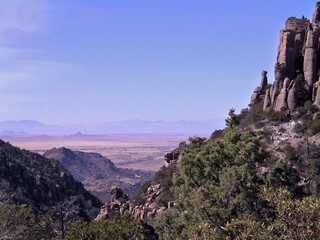 Chiricahua National Monument is at an elevation ranging from 5,180 to7,825 feet in mountains that rise above the surrounding grasslands. This was Chiricahua Apache country. Led by warriors such as Cochise and Geronimo, they were the last Native Americans to hold out against the US Army in later 1800s.. On Monday, Feb 13th we travelled on a rough unpaved road over Apache Pass from Bowie where we were were camped. You can also go around the mountain range on a paved road but it doesn’t have the same feel. We hiked a 3 mile tail in this wonderful area of bizarre rock formations created over the last 27 million years. The forces of erosion have sculpted this 2,000 foot layer of fused volcanic ash into an odd array of strange towers and columns of stacked and balanced stones. No wonder the Apaches could just disappear here.
Chiricahua National Monument is at an elevation ranging from 5,180 to7,825 feet in mountains that rise above the surrounding grasslands. This was Chiricahua Apache country. Led by warriors such as Cochise and Geronimo, they were the last Native Americans to hold out against the US Army in later 1800s.. On Monday, Feb 13th we travelled on a rough unpaved road over Apache Pass from Bowie where we were were camped. You can also go around the mountain range on a paved road but it doesn’t have the same feel. We hiked a 3 mile tail in this wonderful area of bizarre rock formations created over the last 27 million years. The forces of erosion have sculpted this 2,000 foot layer of fused volcanic ash into an odd array of strange towers and columns of stacked and balanced stones. No wonder the Apaches could just disappear here.
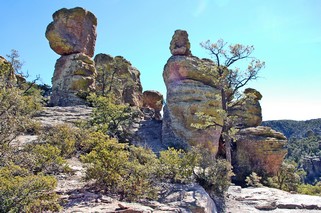
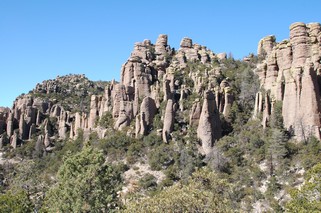
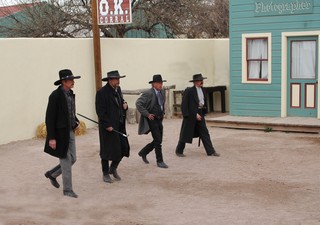
Tuesday we moved to Tombstone and in the afternoon went to the Shootout at the OK Corral. A bit of fun in an interesting town that has kept the main street quite authentic. We went for lunch at Big Nose Kates (she was Doc Holliday’s lady friend) and wandered around the graveyard where Billy Clanton and the McLaury brothers are buried. The gravestones for the years 1881 and 1882 seem to show that the majority of those being buried were murdered, killed in shootouts or “found dead”. Not good years in that town.
The next day we travelled further south to the town of Bisbee which by 1900, wa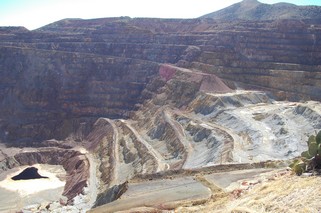 s the largest cosmopolitan center between St. Louis and San Francisco. This was because of the discovery of the Copper Queen Lode. Over the years the Bisbee mines produced more than $2 billion in copper, gold, lead, silver and zinc. By the 1970s most of the mines had closed but artists, art galleries and studios have taken over the town. They have also preserved alot of the Victorian architecture of the town. We took a town tour which included a visit to the open pit mine seen on the right. The pit is 950 feet deep. The slag from the mines is about 3% copper. The town expects Phelps Dodge to come back to reprocess the slag, as with the current price of copper, it is now economical at concentrations of only 1 1/2%.
s the largest cosmopolitan center between St. Louis and San Francisco. This was because of the discovery of the Copper Queen Lode. Over the years the Bisbee mines produced more than $2 billion in copper, gold, lead, silver and zinc. By the 1970s most of the mines had closed but artists, art galleries and studios have taken over the town. They have also preserved alot of the Victorian architecture of the town. We took a town tour which included a visit to the open pit mine seen on the right. The pit is 950 feet deep. The slag from the mines is about 3% copper. The town expects Phelps Dodge to come back to reprocess the slag, as with the current price of copper, it is now economical at concentrations of only 1 1/2%.
We arrived in Tuscon on Thursday, Feb 16th. Both of my sisters are on holidays in the southwest during February. Joan is in Tuscon and Madeline in Mesa. It was great to get to see them. With us on the road, it is harder to get together with family so we take the opportunity when we can.
We spent a week in Tuscon and visited the historic downtown, took a day off to do nothing, got a hair cut, did a number of loads of wash and went to Joan’s for dinner. On Monday, Madeline & George came down from Mesa and the next day we all went to Nogales Mexico. It was fun bartering with the shop keepers – a real battle of wills. We stopped at a casino on the way home and left our contribution to the community.
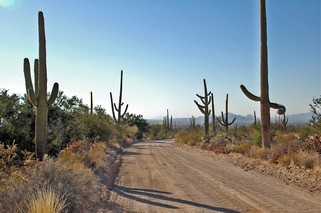 On Wednesday we went out to the Arizona-Sonora Desert Museum and then to Saguaro National Park. The Museum is a combination of zoo and plants that thrive here in the Sonoran Desert region. The Saguaro cactus are everywhere. We learned that they can live to be up to 200 years old and grow very slowly. They don’t usually even produce “arms” until they are at least 35 years old. They absorb water when it rains but there has been a terrible drought and right now they are quite slender. A good rain can provide them with enough water for them to live on for up to 2 years.
On Wednesday we went out to the Arizona-Sonora Desert Museum and then to Saguaro National Park. The Museum is a combination of zoo and plants that thrive here in the Sonoran Desert region. The Saguaro cactus are everywhere. We learned that they can live to be up to 200 years old and grow very slowly. They don’t usually even produce “arms” until they are at least 35 years old. They absorb water when it rains but there has been a terrible drought and right now they are quite slender. A good rain can provide them with enough water for them to live on for up to 2 years.
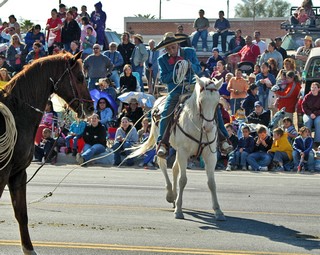
The Tuscon Rodeo was in town and the parade was on Thursday Feb. 23rd. We were amazed. The Rodeo is so important that the schools were closed for two days – the Thursday and Friday.
It is the largest non motorized parade in the country and there were 114 entries in the parade. Talk about horse power! Actually, it was a great parade and there were 10s of thousands of people out to watch it.
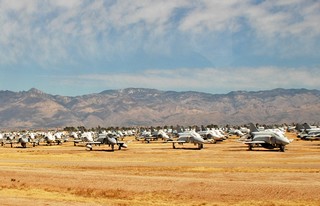
Before we left Tuscon, Ross took a tour of the Aircraft Maintenance and Regeneration Centre at the Davis-Monthan Air Force Base. It’s nicknamed “the boneyard”. This is one of the areas where the U.S. Armed Forces send their surplus or obsolete planes for storage, parts or demolition. The tour took him right out among approximately 5,000 planes.
We are now heading west along Interstate 8. We haven’t decided whether to go into Mexico or not. I guess we had better make up our minds soon. We’ll see.
Bernie & Ross
Posted by Ross at February 26, 2006 10:10 AM
Comments
Great pictures. If you go to Mexico, don't drink the water (tequila's fine).
Posted by: Jill and Alan at March 23, 2006 08:27 AM